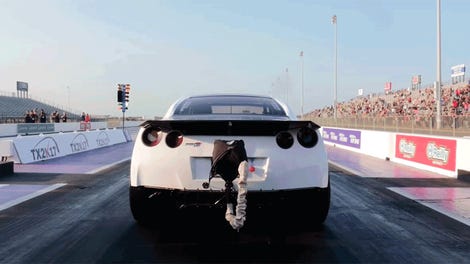
The Nissan GT-R is this generation’s reigning king of tuner cars. A quick search of YouTube alone yields turnt-up GT-Rs with 800, 1,200 or even over 2,500 horsepower. Fun fact! This was not what Nissan had in mind when first it sold the car to us.
Just last week, we saw AMS Performance’s incoherent beast of a GT-R run a quarter mile in 6.937 seconds. That, in drag racing terms, means that it’s a six-second car. Take your ten-second car and get outta here, Dominic Toretto.
When the R35 GT-R first hit our shores in 2008, it quickly rose to stardom the old-fashioned way: by utterly obliterating the competition with straight-line races and blistering lap times, despite being as heavy as a building and costing a fraction of the price of some Italian exotic. The first GT-R was a steal at about $70,000 all while being capable of doing the zero to 60 mph dash in the mid-threes. It was also faster around the Nürburgring than a 911 Turbo.
Advertisement
Advertisement
In an old Top Gearreview, Jeremy Clarksoncricked his neck because the car cornered too hard. Like, what? Sure, he probably wasn’t in the best of shape, but still.
And that was what it could do stock.
Like the Skyline GT-Rs before it, the car would inevitably catch the eye of the tuning community, with gearheads everywhere salivating at the thought of what could be done to that twin-turbo V6 engine. But clearly, Nissan’s engineers had other things in mind.
Sponsored
To them, the GT-R was perfect, sculpted in a wind tunnel and with a body, suspension, aerodynamics and gearbox optimized for performance. The owner’s manual on imported models famously included this warning sticker, which reads “Disallowing illegal or unconventional modifications of the vehicle.”
The warning was ignored immediately.
Advertisement
GT-R owner’s forums published buyer’s guides with suggestions and instructions on how to modify GT-Rs. People started modifying the things seemingly as soon as they got their hands on them.
Indeed, even today the owner’s manual includes strong, repeated warnings against mods, but those seem more for warranty claims than anything else. Add insane mods to your GT-R’s engine, don’t expect to be covered when it blows up.
But that hasn’t stopped anyone. I remember reading about 800-HP Nissan GT-Rs and thinking that was incredible. Now we’re at 2,500 HP and climbing, it seems. Is there a limit? The sky. Maybe.
I think part of the allure lay in the GT-R’s underdog status. When the GT-R first came out, it had a base price of $69,850 and it was still ripping the smirks off Ferrari owners’ faces. So, why stop there? Why not see how far we can really push this thing—and then push it some more just because we can?
Advertisement
Perhaps Nissan has realized exactly how much of a gem it has on its hands: the 2017 GT-R Nismo is now a hundred grand more expensive than the first GT-R, not to mention more powerful and more luxurious than ever. I’m not sure I’m okay with that. But that’s a discussion for another time.
Anyway, we sure showed Nissan.
















